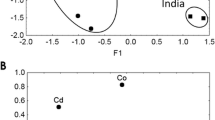Abstract
Arrabidaea chica (Humb. & Bompl.) Verl. is an herb popularly used in the treatment of anemia in the Brazilian Amazon region, and little is known about its mineral content. Therefore, the elemental contents of Cu, Fe, Mn, and Zn were determined in the dried leaves and tea obtained by decoction and infusion of the three varieties of the medicinal plant using flame atomic absorption spectrometry after acid wet digestion of the samples. In general, the levels of the minerals are in good agreement with other studies involving medicinal plants, and the variety AC2 had the highest concentrations of all elements both in dried leaves and tea. Iron was found to be the most abundant in dried leaves (38.4–115.5 µg g−1), whereas manganese had the highest extraction efficiencies both in decoction (56.1–62.7%) and infusion (45.6–63.6%). Additionally, the decoction was more efficient in the extraction of almost all elements. The consumption of the decoction of variety AC2 may contribute to a small proportion to the daily requirements of Mn.

Similar content being viewed by others
References
Cronquist A (1988) The evolution and classification of flowering plants. The New York Botanical Garden, New York
Borrás MRL (2003) Plantas da Amazônia: medicinais ou mágicas? Valer, Manaus
Takemura OS, Iinuma M, Tosa H, Miguel OG, Moreira EA, Nozawa Y (1995) A flavone from leaves of Arrabidaea chica f. cuprea. Phytochemistry 38:1299–1300
Zorn B, García-Piñeres AJ, Castro V, Murillo R, Mora G, Melfort I (2001) 3-Desoxyanthocyanidins from Arrabidaea chica. Phytochemistry 56:831–835
Devia B, Llabres G, Wouters J, Dupont L, Escribano-Bailon MT, Pascual-Teresa S, Angenot L, Tits M (2002) New 3-deoxyanthocyanidins from leaves of Arrabidaea chica. Phytochem Anal 13:114–120
Paes ERC, Ishikawa D, Souza CC, Ferreira LCL, Santos SMPB, Borrás MRL (2005) Formulação de um gel de Arrabidaea chica Verl. (Humb. & Bompl.) e sua ação em feridas provocadas na pele de ratos Wistar. J Bras Fitomed 3:67–73
Jorge MP, Madjarof C, Ruiz ALTG, Fernandes AT, Rodrigues RAF, de Oliveira Sousa IM, Foglio MA, de Carvalho JE (2008) Evaluation of wound healing properties of Arrabidaea chica Verlot extract. J Ethnopharmacol 118:361–366
Shen F, Chen W (2008) Element composition of tea leaves and tea infusions and its impact on health. Bull Environ Contam Toxicol 80:300–304
Fairweather-Tait S, Hurrell RF (1996) Bioavailability of minerals and trace elements. Nutr Res Rev 9:295–324
World Health Organization (2000) Turning the tide of malnutrition: responding to the challenge of the 21st century. WHO, Geneva
World Health Organization (1998). Guidelines for the appropriate use of herbal medicines. WHO, Geneva
Baker AS, Smith RL (1974) Preparation of solutions for atomic absorption analyses of Fe, Mn, Zn, and Cu in plant tissue. J Agric Food Chem 22:103–107
Omolo OJ, Chhabra SC, Nyagah G (1997) Determination of iron content in different parts of herbs used traditionally for anaemia treatment in East Africa. J Ethnopharmacol 58:97–102
Powell JJ, Burden TJ, Thompson RPH (1998) In vitro mineral availability from digested tea: a rich dietary source of manganese. Analyst 123:1721–1724
Özcan M (2005) Determination of mineral contents of Turkish herbal tea (Salvia aucheri var. canescens) at different infusion periods. J Med Food 8:110–112
Sárközi Á, Then M, Szentmihályi K (2005) Mineral element content of greater celandine (Chelidonium majus L.). Acta Aliment 34:113–120
Başgel S, Erdemoğlu SB (2006) Determination of mineral and trace elements in some medicinal herbs and their infusions consumed in Turkey. Sci Total Environ 359:82–89
Nookabkaew S, Rangkadilok N, Satayavivad J (2006) Determination of trace elements in herbal tea products and their infusions consumed in Thailand. J Agric Food Chem 54:6939–6944
Özcan MM, Ünver A, Uçar T, Arslan D (2008) Mineral content of some herbs and herbal teas by infusion and decoction. Food Chem 106:1120–1127
Borrás MRL, Castro da Costa PR, Melo CS, Cyrino BRB, Costa CM, Pinto AS (2001) Caracterización farmacognóstica del crajir—Arrabidaea chica Verlot. Bignoniaceae. Memorias del X Congreso Italo-Latinoamericano de Etnomedicina. In: Congreso Italo-Latinoamericano de Etnomedicina, Caracas, vol. 10, pp. 217–220
Morel JL (1997) Bioavailability of trace elements to terrestrial plants. In: Tarradellas J, Bitton G, Rossel D (eds) Soil ecotoxicology, 1st edn. CRC, Boca Raton
Lambers H, Poorter H (2004) Inherent variation in growth rate between higher plants: a search for physiological causes and ecological consequences. In: Caswell H (ed) Advances in ecological research, vol 34. Academic, New York
Clemens S, Palmgren MG, Krämer U (2002) A long way ahead: understanding and engineering plant metal accumulation. Trends Plant Sci 7:309–315
Özdemir Y, Güçer Ş (1998) Speciation of manganese in tea leaves and tea infusions. Food Chem 61:313–317
Costa LM, Gouveia ST, Nóbrega JA (2002) Comparison of heating extraction procedures for Al, Ca, Mg and Mn in tea samples. Anal Sci 18:313–318
Kumar A, Nair AGC, Reddy AVR, Garg AN (2005) Availability of essential elements in Indian and US tea brands. Food Chem 89:441–448
Shun-Xing L, Feng-Ying Z, Xian-Li L, Wen-Lian C (2005) Speciation analysis and the assessment of bioavailability of manganese in phytomedicines by extraction with octanol and determination by flame atomic absorption spectrometry. Phytochem Anal 16:405–410
Acknowledgements
Igor R. S. Magalhães was supported by a fellowship from Conselho Nacional de Desenvolvimento Científico e Tecnológico (CNPq). The authors are also grateful to Prof. Cynthia Tereza Corrêa da Silva (Universidade Federal do Amazonas), Dr. José Jackson Xavier, and Maria da Conceição Campelo (Empresa Brasileira de Pesquisa Agropecuária) for their technical assistance.
Author information
Authors and Affiliations
Corresponding author
Rights and permissions
About this article
Cite this article
dos Santos Magalhães, I.R., de Oliveira Soares, A., Araújo, L.M. et al. Determination of Cu, Fe, Mn, and Zn in the Leaves and Tea of Arrabidaea chica (Humb. & Bompl.) Verl.. Biol Trace Elem Res 132, 239–246 (2009). https://doi.org/10.1007/s12011-009-8381-2
Received:
Accepted:
Published:
Issue Date:
DOI: https://doi.org/10.1007/s12011-009-8381-2



